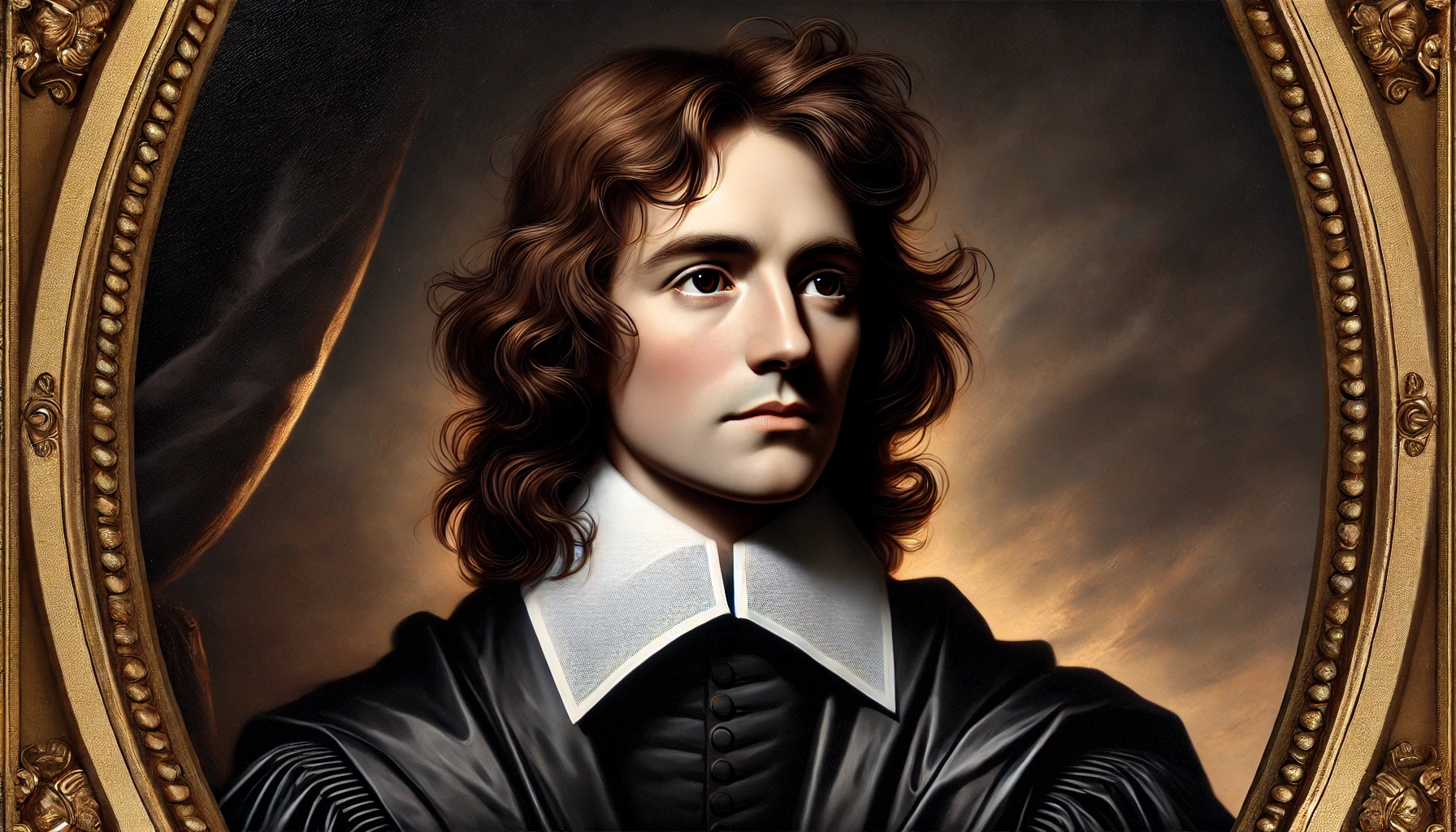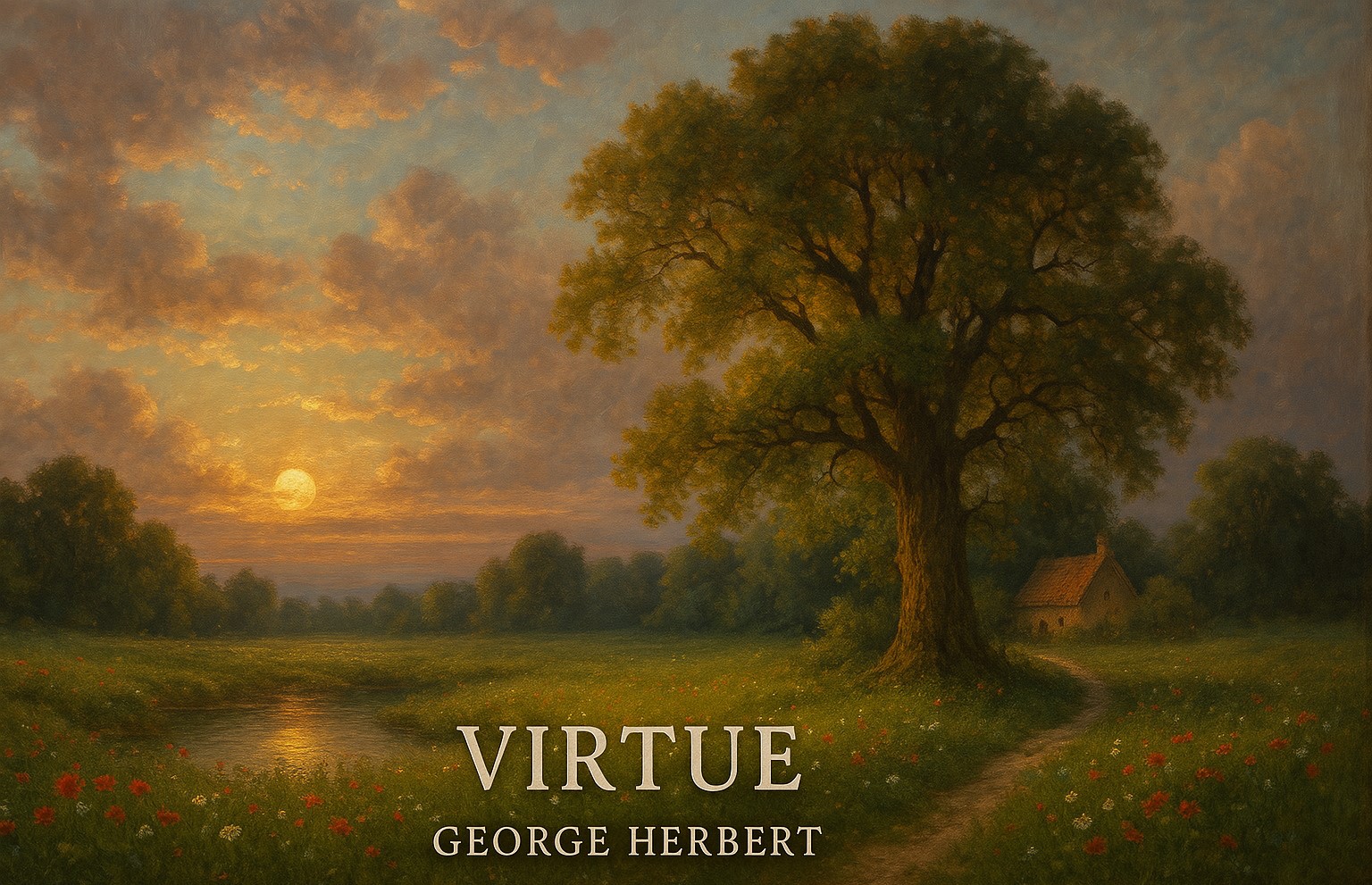Introduction
George Herbert (1593–1633) was an English poet, orator, and Anglican priest, best known for his devotional poetry and association with the Metaphysical Poets. His work including "The Colar, The Pulley, Virtue and Redemption" gave a bigger impact in literature.

Virtue by George Herbert
"Virtue" by George Herbert is a metaphysical poem that expresses on the fleeting nature of life and the enduring power of virtue. The poem consists of four quatrains with an ABAB rhyme scheme.

Summary:
- First Stanza: The speaker describes the beauty of a sweet day with its coolness, calmness, and brightness. However, even this lovely day must die as night falls.
- Second Stanza: A rose is personified as "angry and brave" which blooms brilliantly, but it too is mortal and will eventually wither and die.
- Third Stanza: Spring, full of sweet days and roses which is celebrated, but even this vibrant season must come to an end.
- Final Stanza: In contrast to the transience of earthly beauty, virtue is immortal. The speaker declares that even when the world ends ("the whole world turn to coal"), virtuous souls will live on never fading.
Theme:
The poem opposes the temporary nature of "earthly beauty" with the eternal nature of virtue, and it is suggesting that true goodness outlasts all worldly things.
The Pulley by George Herbert: Summary
"The Pulley" is a metaphysical poem by George Herbert that explores God’s relationship with humanity, and it is focusing on the idea of divine grace and human restlessness. The title refers to a mechanical pulley, and it is symbolizing the way God lifts humanity toward Himself through struggle.
Summary:
- God’s Blessings – The poem begins with God pouring out blessings upon humanity, granting strength, beauty, wisdom, honor, and pleasure. In the poem, almost everything a person could desire.
- The One Withheld Gift – However, God decides to withhold "rest" (peace and contentment), additionally, he fears that if humans had everything then they would worship their gifts instead of the Giver.
- The Pulley Metaphor – The poem concludes with the idea that human restlessness (the lack of "rest") will act like a pulley, and it draws people back to God. By feeling incomplete, humans will seek divine fulfillment.
Theme:
- Divine Wisdom & Human Dependence – God intentionally leaves humans restless so they will turn to Him.
- Grace & Longing – Suffering and dissatisfaction serve a purpose—leading humanity toward spiritual reliance on God.
Structure & Style:
- Written in a conversational tone which blends simplicity with deep theological insight.
- Uses metaphysical conceit (the pulley as a symbol of spiritual mechanics).
- Rhyme Scheme: ABABA (five-line stanzas).
The Collar by George Herbert Summary and Analysis
"The Collar" is a dramatic rebellious poem in which the speaker (likely a priest or devout Christian) angrily questions his life of religious discipline before ultimately submitting to God’s call. The title plays on the word "collar"—referring both to a clerical collar (symbolizing duty) and a restraint (like a dog’s collar).
Summary:
- The Speaker’s Outburst – Frustrated and weary, the speaker lashes out, rejecting the constraints of his faith. He complains about the lack of freedom, pleasure, and worldly rewards in his spiritual life.
- "I struck the board, and cried, 'No more! / I will abroad!'"
- He mourns lost opportunities for wealth and pleasure, feeling his sacrifices are pointless.
- Defiance & Doubt – He questions why he must endure hardship while others enjoy life.
- "Have I no harvest but a thorn / To let me blood?"
- He resolves to abandon his faith and seek earthly pleasures instead.
- Divine Interruption – Just as his rebellion peaks, he hears God’s gentle call:
- "Me thought I heard one calling, Child! / And I replied, My Lord."
- Instantly, his anger dissolves, and he submits, recognizing God’s love.
Key Themes:
- Struggle Between Flesh and Spirit – The tension between human desires and divine duty.
- Freedom vs. Submission – The speaker initially sees faith as oppressive but realizes true peace comes from surrendering to God.
- Grace & Love – God’s quiet call contrasts with the speaker’s rage, highlighting divine patience.
Literary Techniques:
- Dramatic Monologue – The raw, emotional voice mimics a soliloquy.
- Metaphor – The "collar" represents both restriction and vocation.
- Imagery – Thorns, blood, and harvests evoke sacrifice and suffering.
- Sudden Shift – The poem’s turn (volta) mirrors a moment of divine grace.
Structure:
- Free Verse – Irregular lines and punctuation mirror the speaker’s turbulent emotions.
- Rhyme Scheme – Mixed, reflecting his disordered thoughts before resolving into order.
Final Message: Even in rebellion, God’s love reclaims the wanderer. The "collar" is not just a chain but a mark of belonging.
"Redemption" by George Herbert – Summary & Analysis
"Redemption" is a sonnet from George Herbert’s The Temple (1633), blending metaphysical wit with biblical allegory to explore the Christian concept of salvation. The poem presents a tenant-landlord metaphor, where the speaker (a sinner) seeks renewed terms of grace from God (the heavenly landlord).
Summary:
- The Speaker’s Request (Lines 1–4)
- The speaker, a "tenant" to God’s "great lord," acknowledges his lease (life) is expiring due to sin.
- He humbly asks for a new agreement (redemption) but finds God has left His heavenly estate.
- The Search for God (Lines 5–10)
- The speaker searches for God in wealthy places (palaces, courts) but only finds worldly grandeur, not divinity.
- Finally, he encounters Christ in a ragged, humble setting (alluding to the Crucifixion):
- "There I him espied, / Who straight, Your suit is granted, said, and died."
- The Paradox of Redemption (Final Couplet)
- Christ’s death instantly grants the speaker’s plea, fulfilling the Christian doctrine that salvation comes through Christ’s sacrifice.
Key Themes:
- Divine Grace vs. Human Effort: The speaker’s futile search contrasts with Christ’s immediate, unearned gift of redemption.
- The Humility of Christ: God is found not in power but in suffering (a central Herbert theme).
- Legal Metaphor: The "lease" frames salvation as a divine contract renewed through Christ’s death.
Literary Techniques:
- Sonnet Form:
- Structure: 14 lines (ABABCDCDEFEFGG), with a volta (turn) at line 9 when Christ appears.
- Rhyme: The final couplet delivers the theological punchline.
- Allegory: The tenant-landlord relationship mirrors Luke 20:9–16 (Parable of the Tenants).
- Irony: The speaker expects to find God in opulence but discovers Him in a scene of poverty and death.
Notable Lines:
- "In heaven at his manor I him sought" → God’s absence hints at the Incarnation (God leaving heaven for earth).
- "Your suit is granted, said, and died" → Christ’s death is the legal fulfillment of redemption.
Conclusion:
Herbert’s poem compresses the Gospel narrative into a single, poignant moment. The speaker’s journey mirrors humanity’s struggle to earn grace, only to find it freely given through Christ’s sacrifice. The legal metaphor underscores Herbert’s belief in salvation as a divine gift, not a human achievement.
Link to Herbert’s Other Works:
- Like "The Collar," it shows rebellion yielding to submission.
- Like "The Pulley," it portrays God’s strategic withholding (here, His presence) to inspire dependence.
Conclusion on George Herbert and His Works
George Herbert (1593–1633) remains one of the most celebrated metaphysical poets, renowned for his deep spiritual introspection, intricate metaphors, and masterful use of form. His poetry explores themes of faith, divine love, human struggle, and surrender to God, often blending personal emotion with theological depth.
Key Aspects of Herbert’s Works:
- Religious Devotion & Struggle – His poems, like "The Collar," "The Pulley," and "Virtue," depict the tension between earthly desires and spiritual commitment, ultimately affirming God’s grace.
- Metaphysical Conceits – Herbert uses striking analogies (e.g., the pulley, the collar) to illustrate complex spiritual truths.
- Structural Ingenuity – Many poems, such as "Easter Wings" (shaped like wings), employ visual and rhythmic creativity to reinforce their themes.
- Humility & Submission – Unlike John Donne’s dramatic intensity, Herbert’s voice is quieter, marked by humility and resignation to divine will.
Legacy:
- Herbert’s collection "The Temple" (1633) profoundly influenced later poets like Henry Vaughan, T.S. Eliot, and W.H. Auden.
- His works bridge Renaissance humanism and Puritan piety, offering a timeless meditation on faith’s challenges and consolations.
Final Thought: Herbert’s poetry endures because it captures the universal human experience—doubt, longing, and the search for divine connection—with lyrical grace and intellectual depth. His verses remain a testament to the power of faith refined through struggle.